HE-400i (2020)
back to HIFIMAN
back to measurements
home
published: Apr-30-2022
NO SMOOTHING is applied to the shown plots. Most measurement sites have some smoothing applied which ‘irons flat’ sharp peaks and ‘wiggles’. I do not use smoothing because some info about sound quality is lost when plots are smoothed.
Aside from a small correction of the microphone itself also some correction in the lowest frequencies is applied to the plots to compensate for the perceived loss of bass when using headphones. This is described HERE in more detail.
A ‘horizontal‘ frequency response curve on the shown frequency response plots on this website thus indicates a perceived ‘flat’ tonal signature.
ALL measurements are made with a good SEAL on a flatbed measurement rig.
The shape of your head, bone structure, pad size, pad ‘softness, (compliance), hair or no hair and or wearing glasses may (drastically) change the frequency response of some headphones, so… your personal experience may differ substantially from these plots.
Frequency response (tonal balance) is the most sound-determining aspect of headphones. A horizontal line shows audible neutral response in the plots on this website. Deviations in different severities at different frequency bands have an effect on the sound character.
The bigger the deviation the stronger the effect.
Below an aid to help determining the sound character of headphones with relation to the frequency response.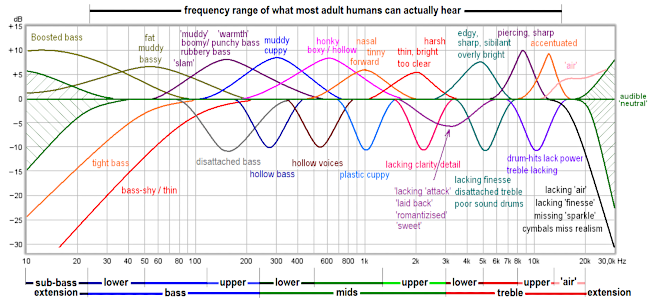
HIFIMAN HE 400i (2020)
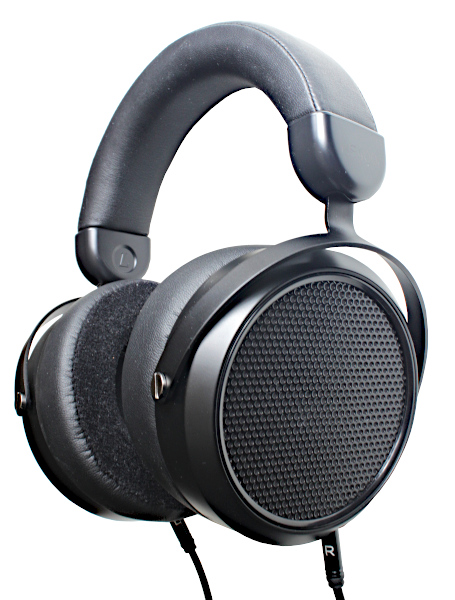
The HIFIMAN HE 400i 2020 is an open over-ear planar magnetic headphone. The MSRP end 2021 was $ 169.-
This is a low price for a planar magnetic headphone, certainly when the sound quality is taken into consideration. For $ 149.- there is the HE 400SE which is the better choice.
It replaces the original HE 400i which was 2.5x more expensive, had different headband and pads.
The reviewed headphone is second hand (so not new in box).
Weighing 390 gram this isn’t one of the lightest headphones around but for a planar headphone it is not a heavy one. Clamping force is fine 4.5N, but may be higher when new.
Fortunately due to the soft and wide headband and the large contact area of the pads on the skin the weight and clamping force is comfortable.
The headband can extend 35mm (clicking sliders) and can be pulled apart quite a distance (200mm). Padding is firm regular foam covered with pleather. This may start to flake after a few years of usage.
The headband feels sturdy.
The pads are hybrid type so different materials were used. The surface that makes contact with the skin is velour. The outer side is pleather (fake leather) and the inside is perforated pleather. The pads have a 12° angle which helps with the stereo image width. The foam inside is regular foam (so not memory-foam) and feels quite firm. The pads are removable and fitted on a thin plastic ring that hooks onto the cups on 4 spots. The pads, while fancy looking and feeling, appear to be made cheaply. Given the going price this isn’t strange though.
The cups only have a enough swivel and can rotate 360 degrees (without a cable attached to it) and are painted in a nice matte black color (no fingerprint magnets). The original HE400i had a dark blue-purple-ish color.
There is a non-locking 3.5mm TRS socket in each cup. When the cable is janked the plugs come out but fit snugly enough so that they don’t fall out easily.
It requires some force to adjust the cups to their proper position. When the headphone is taken off the cups stay in that position. I have no idea how long it stays this way.
With a sensitivity of 108dB/V (efficiency = 94dB/mW) and low impedance (42 Ω measured) this headphone plays moderately loud directly from a phone. A decent headphone amplifier or source that can supply at least 100mW in 32Ω is recommended.
The supplied (black) cloth covered cable is quite stiff and ‘springy’ mildly microphonic (touching the cable is just audible in the headphone). The connectors come out of the cups with a small forward angle so the cable drapes in front of the listener. The cable split is 50cm below the headphone itself. With a 1.5m length it is a good length for desktop duty and even portable usage.
The cable is terminated in an angled gold plated 3.5mm TRS plug with a 6.3mm adapter (not screw-on). On the headphone side there are 3.5mm TRS plugs with L and R markings on it.
All in all this headphone feels sturdy. Clamping force is a good (4.5N) and can be lowered a bit further by carefully stretching the headband a bit. Comfort is good
This reviewed (used) HIFIMAN HE400i (2020) is for sale
specifications:
Type: over ear (circum-aural), open
Usage: home
Driver type: planar magnetic
Pads: replaceable 12° angled hybrid
Collapsible: no
Headphone cup connector: 2x 3.5mm TRS
Cable entry: dual sided.
Cable: 1.5m terminated in angled 3.5mm TRS jack + push-on 6.3mm adapter
Inner Pad dimensions: depth front = 25mm, depth rear = 30mm , diameter = 55mm.
Driver size: 70mm
Nom. power rating: 2 W (estimated)
Max. voltage: 9 Vrms (26Vpp)
Max. current: 215 mA
Max. S.P.L.: 127 dB
Impedance: 42 Ω (measured)
Efficiency: 94dB @ 1mW
Sensitivity: 108dB @ 1V
Weight: 390 g. (without cable)
Clamping force: medium-high (4.5N)
Accessories: 6.3mm adapter
Subjective sound description:
Bass is present and of good quality but a bit ‘soft’ in character (as in not ‘tight’ or ‘punchy’). Integration from bass to mids is seamless. Bass extension is there but movie ‘ thumps’ are a tad low in amplitude.
The mids sound dynamics and are not ‘forward’ but ‘laid back’ smooth and distortion free even at higher listening levels. The mids have a warmish character.
Treble is smooth but has a sharp edge on it. This, however, is easily solved with some EQ or filtering.
Aside from treble peak (which some will perceive as highly detailed) this headphone is pleasant to listen to without further EQ. Lifting the upper mids a bit makes the HE400i (2020) a bit clearer sounding but is not essential for people enjoying a ‘relaxed’ sound.
Harman-bass lovers will want the lower bass lifted.
Measurements:
Below the frequency response of the HE 400i (2020) (Left, Right)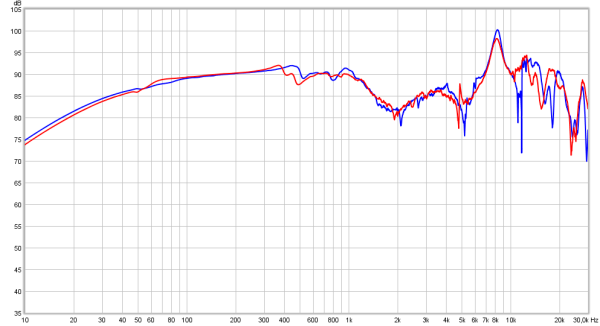 The channel matching is excellent, which is quite common with HIFIMAN models. Bass extension is also good but bass starts to gently roll-off below 70Hz. Up to 1kHz the response is very even. Between 1kHz and 3kHz there is the typical HIFIMAN dip. This is found on as good as any model they have. This dip, in reality, is slightly less deep than what the measurements suggest due to the angle of the pads and the interaction with the pinna. As the measurement fixture does not have a pinna the 1-5kHz range is under-reported a bit.
The channel matching is excellent, which is quite common with HIFIMAN models. Bass extension is also good but bass starts to gently roll-off below 70Hz. Up to 1kHz the response is very even. Between 1kHz and 3kHz there is the typical HIFIMAN dip. This is found on as good as any model they have. This dip, in reality, is slightly less deep than what the measurements suggest due to the angle of the pads and the interaction with the pinna. As the measurement fixture does not have a pinna the 1-5kHz range is under-reported a bit.
That dip (which is still there, just not as deep) is responsible for the ‘laid-back’ sound signature. Filling in that dip results is clearer mids.
For a lot of popular recordings that dip is actually helping making some recordings less shouty.
compared to
Given the price point and looks some people believe the HE400SE is simply the HE400i (2020) with different color cups. 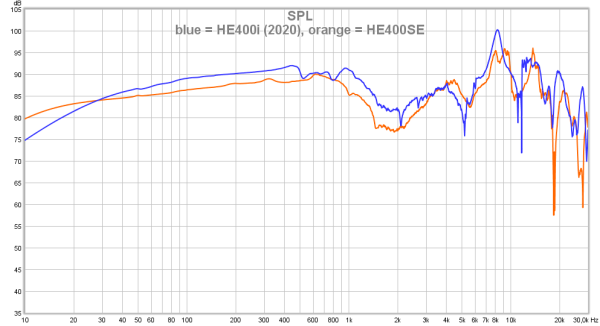 This is not the case. There is a difference in tonal balance, bass extension, impedance and efficiency.
This is not the case. There is a difference in tonal balance, bass extension, impedance and efficiency.
Below (alternating every 3 seconds) the HE400i (2020) versus a few other HIFIMAN models such as the original HE400i, HE400SE, HE400S, (HE350 and HE35X which are dynamic HIFIMAN headphones), HE560, Sundara, Drop Edition XX, Edition X(v2), Ananda, HE1000 and Susvara. Also a Sennheiser HD600 and HD800S are shown as these are well known.  The ‘signature’ dip around 2kHz is present in all models. Biggest differences between most models occur above 3kHz and sometimes below 100Hz. This largely determines the sound signature differences between these models as well as pads being angled or not.
The ‘signature’ dip around 2kHz is present in all models. Biggest differences between most models occur above 3kHz and sometimes below 100Hz. This largely determines the sound signature differences between these models as well as pads being angled or not.
The plots are ‘smoothed’ by 1/12th octave to get a better feel of the tonal balance. Some models have sharp peaks and dips though which are not as visible but can impact the sound.
phase response
Below the phase response of the HE 400i (2020) (Left, Right)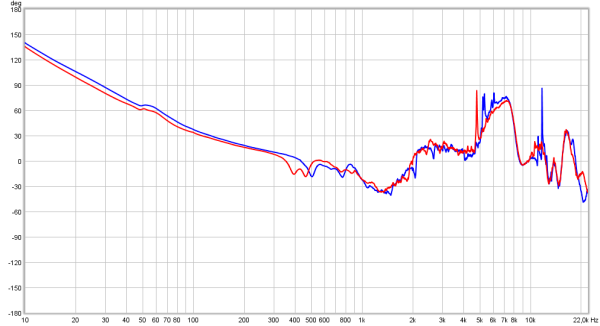 Slow phase shifts are not very audible. Sharp changes in a narrow frequency bands may well be audible.
Slow phase shifts are not very audible. Sharp changes in a narrow frequency bands may well be audible.
Only above 5kHz there are some sharper, but not extreme, phase shifts.
output resistance / damping-factor
As this is a planar magnetic headphone the frequency response is unlikely to be amplifier output resistance dependent.
The HE 400i (2020) is measured via a 4 different resistance outputs (0.2Ω, 10Ω, 32Ωand 120Ω). On a higher output resistance amplifier the output level will be lower of course due to voltage division. To compensate for this the amplifier is cranked up to the same level (11.5dB for 120Ω at 1kHz in this case). This way the plots are overlaid and it is easier to see how the tonal balance changes. 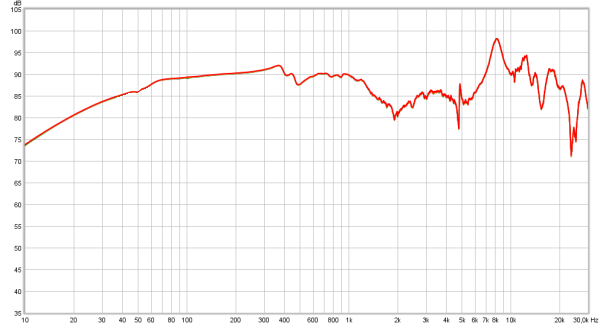 The traces all overlay so we can only see the red trace.
The traces all overlay so we can only see the red trace.
Different output resistances between the mentioned resistance values will thus not result in tonal changes.
Linearity
While there was no reason to suspect linearity issues the HE400se is measured 3 times. Once at 70dB, 80dB, 90dB and 96dB SPL. When the traces are overlaid and have the same shape then there is no compression. Note: the vertical dB scale is 2dB/division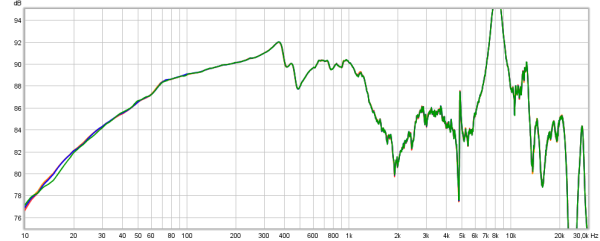 The 70dB, 80dB and 90dB traces are hiding behind the 96dB trace so there is no indication of compression going on till at least 96dB SPL. Excellent !
The 70dB, 80dB and 90dB traces are hiding behind the 96dB trace so there is no indication of compression going on till at least 96dB SPL. Excellent !
seal
Seal can be an issue with closed-back headphones. Much less so with open headphones, which the HE 400i (2020) is. Most open headphones also have some porting around the driver which is not the case with planar headphones. Perfect seal, using thin armed glasses, thick armed reading glasses, and pads lifted a few mm.
Breaking the seal does make bass extension drop a bit but also increases lower bass levels.
With a substantial seal breach bass response drops off below 60Hz but there is an audible 3dB boost at 70Hz. Smaller seal breaches do not affect the response very much.
Below the distortion measurements of the HE 400i (2020) (Right channel).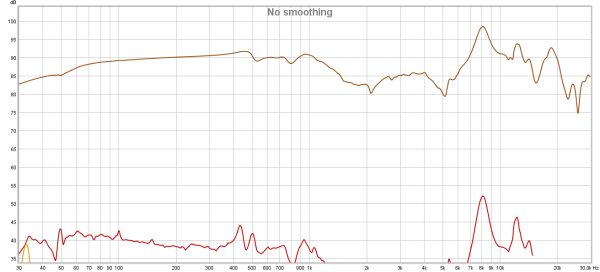 The measurements are made at 90 dB SPL.
The measurements are made at 90 dB SPL.
The plot above shows the level differences between the signal (upper trace) and the harmonics.
Most people prefer to see percentages instead of level differences so below the exact same plot except ‘normalized’ to the actual signal and level differences given in percentages.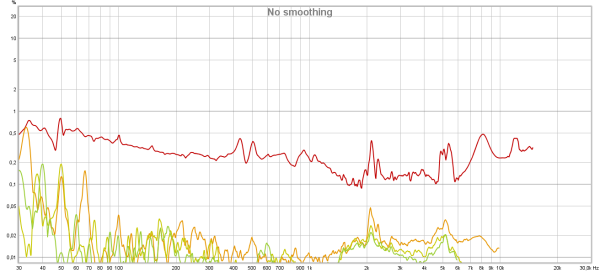 Distortion levels are very low and is exemplary.
Distortion levels are very low and is exemplary.
The actual 2nd harmonic distortion may well be lower. A shortcoming of my measurement rig.
Below the CSD (waterfall) plot of the HE 400i (2020) (Left and Right are overlaid) The CSD is quite a mess and shows multiple resonances. Left and right channel also do not react in the same way. As the ringing goes on much longer than we usually see below the same plot but not spanning 5ms but 15ms (from back to front).
The CSD is quite a mess and shows multiple resonances. Left and right channel also do not react in the same way. As the ringing goes on much longer than we usually see below the same plot but not spanning 5ms but 15ms (from back to front).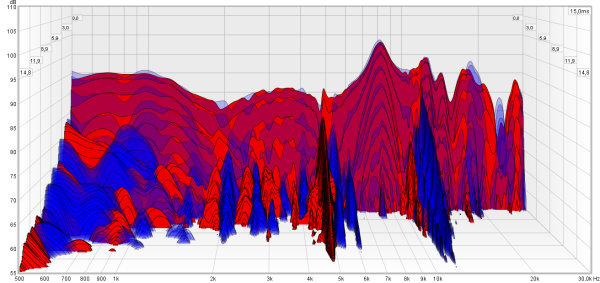 This shows excessive ringing at around 5kHz and 12kHz.
This shows excessive ringing at around 5kHz and 12kHz.
These resonances are seen in many HIFIMAN planar models. This is not typical for all planar headphones though. Audeze headphones do not show resonances lasting this long. The resonances are very narrow so I don’t think it is a sound quality degrading issue.
Below the Group Delay plot for the HE 400i (2020) (Left, Right) At between 50Hz and 70Hz there is a very small amount of pad bounce visible but this certainly isn’t audible. the Right channel shows some resonance at around 400Hz where the left channel does this at 500Hz. Also some (very narrow) spikes at 2kHz, 5kHz and 12kHz.
At between 50Hz and 70Hz there is a very small amount of pad bounce visible but this certainly isn’t audible. the Right channel shows some resonance at around 400Hz where the left channel does this at 500Hz. Also some (very narrow) spikes at 2kHz, 5kHz and 12kHz.
A different plot is the spectrum plot. This basically is a CSD (Waterfall) plot but viewed from above where the level differences are color coded instead of being in the vertical axis. Also the frequency range of the spectrum plot is wider (from 100Hz instead of 500Hz). The time span is also bigger in the spectrum plots and expired time is shown from below to top where in the CSD the time is shown from rear to front.
Below the spectrum plot of the HE 400i (2020) (Left channel)
Because there are differences between left and right drivers below a similar plot but from the right channel. Bass is well damped and decays quickly . At various frequencies the HE400i drivers like to vibrate a bit longer. Around 10kHz the resonance is at its longest. This can also be seen in the step response below. Left and right channel do this at different frequencies and lengths.
Bass is well damped and decays quickly . At various frequencies the HE400i drivers like to vibrate a bit longer. Around 10kHz the resonance is at its longest. This can also be seen in the step response below. Left and right channel do this at different frequencies and lengths.
Step response
Below the step response plot which, when the sound is balanced and well extended should show a fast rise to around 0dB, (indicating fast driver response) and then should be slightly sloping downwards indicating bass extension. (Left, Right) The sharp rise shows the driver responds really fast. This is also seen in the frequency response plot as it easily reaches beyond 30kHz. The 12kHz resonance of the left channel is still visible even up to 5ms.
The sharp rise shows the driver responds really fast. This is also seen in the frequency response plot as it easily reaches beyond 30kHz. The 12kHz resonance of the left channel is still visible even up to 5ms.
The small dip after the initial rise shows the laid back character. The sharp rise masks this effect a bit by adding some sharpness to the sound. The horizontal trace drops slowly indicating excellent subbass extension is there but at a somewhat lower than ideal level.
treble peak filtering
That treble peak at 8kHz is definitely audible to most people. It is present in sharpness band (7kHz to 10kHz). Some people have a dip in that part of the frequency range where others have this higher up. So not everyone may be bothered by it depending on the shape of their outer ear (pinna).
The peak makes the sound ‘sharper’ and gives a sense of the sound being highly detailed. To some folks that peak is annoying and the sharpness can even reach unpleasant levels. Fortunately that peak can be removed with some EQ or by using the passive filter below. When parametric EQ or graphic EQ with a narrow band at 8.5kHz is not available or an option and you like how it sounds otherwise the above filter will effectively remove the treble spike and make the treble sound smoother.
When parametric EQ or graphic EQ with a narrow band at 8.5kHz is not available or an option and you like how it sounds otherwise the above filter will effectively remove the treble spike and make the treble sound smoother.
Below the effect the filter has on the frequency response of the HE400i (2020).
Below the measured frequency response of the HE400i (2020) with the filter (Left, Right). The sharpness is removed but treble extension remains the same. This cannot be achieved using some damping materials in front of the driver. Of course using parametric EQ the same can be done and the rest of the frequency response can also be corrected. Not everyone can use parametric or graphic EQ with this narrow bands. In such cases, when bothered by the sharpness, the passive inline filter is a very good option.
The sharpness is removed but treble extension remains the same. This cannot be achieved using some damping materials in front of the driver. Of course using parametric EQ the same can be done and the rest of the frequency response can also be corrected. Not everyone can use parametric or graphic EQ with this narrow bands. In such cases, when bothered by the sharpness, the passive inline filter is a very good option.
conclusion
The HIFIMAN HE 400i (2020) is a cheap planar headphone with good sound quality. This headphone represents high value for money and is recommended for folks wanting to venture in the planar magnetic headphone world and also for those looking for a very good sounding open headphone in general. A cheaper option with better bass extension and the same comfort looks may be better off buying the HE400SE.
Bass heads will be disappointed but they can EQ lots of bass in without any downsides but will need a beefier amplifier.
There is good bass extension (though a bit bass light for Harman bass lovers). The laid-back sound signature (not bright/forward/clear) may be a tad too relaxed sounding for people who like some ‘snap’ or ‘bite’ to the sound. Also the treble sharpness peak may not be appreciated by everyone.
Fortunately this headphone responds very well to EQ (with no downsides).
Still a lot of people will be perfectly happy with the sound as is. It is a very enjoyable sound.
The sensitivity of this headphone, with 108dB/V is a few dB higher than the HD6** series.
This means you can use it directly from a phone or USB dongle for longer haul casual listening but cannot reach impressive levels. This is something the HE400i is very good at though when driven y a more powerful amplifier. The amplifier should at least reach 100mW in 32Ω to reach loud levels without a trace of distortion.
Comfort is good. Clamping force is a bit on the high side out of the box but can be lowered a bit.
The pads and headband are comfortable. Pad depth is excellent but people with bigger ears (mostly older people as ears keep growing) may find the 55mm diameter on the small size.
Build quality of the pads appears to be a bit cheap but is not poor.
The overall build quality of the headphone itself feels sturdy. The tilting of the cups is a bit stiff and requires some (small) force to adjust. This means in order to get a good seal the cups have to be manually positioned and don’t go in the correct position by themselves.
The supplied cable is stiff/springy and has some low frequency microphonics. So touching the cable or the cable rubbing against clothes is audible without any music playing. With music playing it is inaudible to me.
